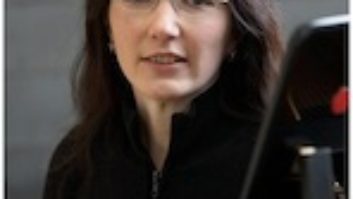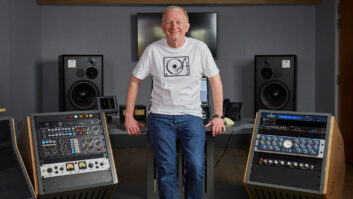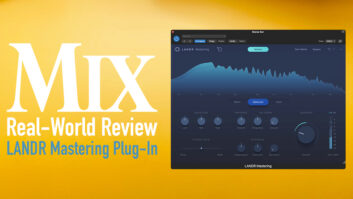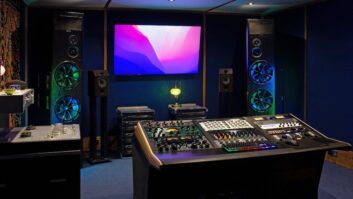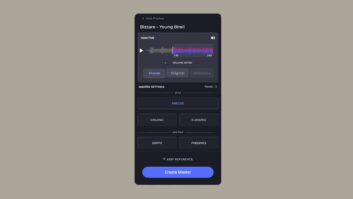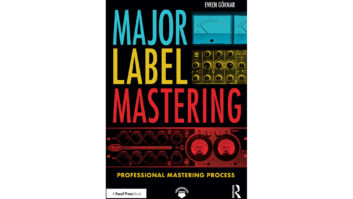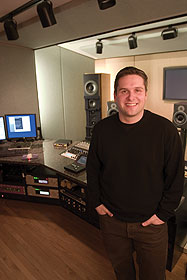
Mastering is possibly the most solitary job in the music-production chain. An engineer with a pair of golden ears and a collection of singular equipment works alone in a pristine room, turning mixes of all sorts into dynamic, polished records. However, mastering pros, like recording engineers and mixers, are in a service business; pleasing clients remains their ultimate goal, and collaboration is a crucial part of their process.
We talked to three mastering professionals—all Grammy winners and all at the top of their craft—about the ways they collaborate fruitfully with clients, whether or not they ever meet those clients in person, share the same time zone or even speak the same language.
Gateway Mastering’s Adam Ayan FTPs a couple tracks to remote clients for their once-over.
When we phoned Gateway Mastering’s Adam Ayan, he was in the thick of a week when four of five days were booked with attended sessions. “But that’s not typical at all,” Ayan says. “It’s usually the opposite. I would say that 90 percent of the time I’m working unattended.”
This is not too surprising, as Gateway is situated in Portland, Maine—not exactly a music-recording hub. When founder and mastering legend Bob Ludwig opened Gateway in the mid-’90s, most of his projects arrived via FedEx. Now, Ayan makes a point of FTP’ing one or two tracks of an album to his remote clients before he gets too far into a project. “If I’m working with a new client, especially in these days of tighter budgets, I’ll call, and say, ‘Are you available the morning of the session if I send you the very first track I cut that day?’ to try to get on the same page right away,” he says. “I’ll say, ‘Listen to it and see if that’s the direction you want to go.’ In that rare case when somebody wants to take the whole thing in a radically different direction, I want to respect their musical vision and get them there, but you definitely don’t want to find that out at the end of the project and have to start over; it’s all billable hours. I never want to be in a position where a client feels like their artistic vision hasn’t been met, but they have to live with it because they’re on a budget.
“Everybody’s so wired in these days,” Ayan continues. “In a way, it’s so easy to have lines of communication, but the communication itself is different. What might in the past have been a 5-minute phone call is now only a 6-word email, and you need to sift through those things and make a point of getting enough information. This is a collaborative process, and even when—or maybe especially when—you’re working with remote clients, people skills can be just as important as technical skills.”

Stephen Marcussen sees more foot-traffic coming in, allowing back-and-forth talks with the artist.
Stephen Marcussen’s studio in Hollywood sees a lot more client foot-traffic. “It’s a surprising amount of people who show up,” he says. “And as the field broadens, there are a lot more people making music outside of the traditional record-company model and they’re far more engaged in their work. We have more artists attending now, which is great. You’re right at the source, and it doesn’t get any better than that: I make suggestions, they make suggestions. The dismantling of the traditional label model has made my work more engaging on a human level because I see more people.”
However, Marcussen also has a substantial base of clients who send work from Europe, Australia and the Far East; note the Japanese-language icon on his Website. He says that despite the miracle of FTP and the Web in general, true collaboration with foreign clients is often challenging because of the time difference. He carefully plans his schedule to make sure he can connect: “We see both sides of the dateline,” he says. “I’ll communicate with Australia late in the day and Europe early in the day. If they’re in Europe, they’re largely sleeping while we’re working. They’ll wake up, download the project we did, and then email or phone if they want me to make a change. But if there’s a hiccup on their end, with whoever the client contracts with for their Web access, that can shift a project by another day.”
Marcussen says that some of his Japanese clients do visit him in California. The band Spitz, for example, who are on their 13th album with Marcussen, came over last year with their producer and engineer. “There’s usually somebody who comes over with a band like Spitz who speaks English, but if not, there are project coordinators in America who will help artists like this get set up, get comfortable, get to their recording or mastering sessions, and work with the band on getting their points across.”

Andrew Mendelson prefers when clients are there for the mastering sessions.
For Andrew Mendelson, who heads up Georgetown Masters in Nashville, the art of collaboration begins at home, in the relationship he has with his assistants. “Most of my credits will read, ‘Mastered by Andrew Mendelson,’ but I was probably assisted by two or three people,” he says. “Like other assistants, they do all the setup and production work, but they also do all of my loads, all of my doc’ing and most of the editing. It’s very much a team effort. If people come back for a tweak in editing of spacing, for example, they don’t always have to come to me for that. A lot of mastering engineers do work alone, and a lot of the ones I know who use assistants use them more to set up and do the production end, but here they help oversee an entire product, front to back. All of them do their own projects here as well, and that’s a way we can get people into our facility who can’t necessarily afford my rates, which is important as record label budgets keep coming down.”
Mendelson says about 50 percent of his sessions are attended and comprise local Nashville clients and those who come from as far as Europe and the Middle East. For those who can’t be there in person, he says, “We talk on the phone, we email, we use Skype. I think there’s a future in setting up real-time participation in sessions that way as bandwidth gets better, but I do like it when people are here. To me, it’s the difference between being a solo artist and being part of a band. I like that band dynamic, that back-and-forth. I’ve heard stories of other guys who don’t want anyone else sitting in their chairs; it’s bizarre to me. Why would someone screw up their own project?”’
Mendelson acknowledges that a lot of the “family vibe,” as he calls it—the collaborative spirit he shares with his colleagues and his clients—began under the previous president of Georgetown, the late Denny Purcell. “Denny created an environment that people wanted to come to,” Mendelson says. “He was a master of people skills. He knew how to put clients at ease, how to deliver a great product and conduct a session where he’d do great work but have fun while doing it. That’s a legacy we’re trying our best to live up to.”
Ayan also sees his mentor, Ludwig, as an important collaborator. The two engineers rarely combine forces on an album, but they do work on identical setups, and sharing information can save some of those all-important billable hours. “We have the advantage of shared knowledge and experiences,” Ayan says. “We’ll see each other at lunch or in the hallway, and say, ‘Oh, I just found a bug in this program; look out for this.’ If we’re both unattended and I find something important, I will buzz Bob’s studio or run down there, and say, ‘I found this wrong with this piece of equipment,’ and he does the same for me.”
Along the lines of the collaborative spirit, it’s also worth noting that Ayan founded the Portland Music Foundation, a nonprofit that sponsors educational workshops and events designed to unify the local music community. “You get this feeling of folks working in their own project studios now,” Ayan explains. “They can work when the moment strikes them, spend as much time as they want without being on the clock—all of those good things. But the negative side is they don’t have anybody to bounce ideas off of. They don’t collaborate even in the minimal way that Bob and I do. We’re off the beaten path, but we have a pretty cool, thriving music community here, and the Portland Music Foundation is a way to bring that community together, anchor and strengthen it.”
For most mastering engineers, the new normal of working alone in a project room may not represent a radical shift as it has for the recording community, but the era of the “6-word email” has made the opportunity to collaborate with real live clients a rare treat.
“It’s nice to work with somebody here because I enjoy the company,” Marcussen says. “And there’s more [to collaborating] than just words. There’s body language, facial expression, the look of, ‘Wow, that’s great!’ or, ‘I’m not sure I’m getting that.’ It’s much more immediate, and working with people is still my ideal scenario, but if they’re not able to attend, you can still accomplish quite a bit.”
Barbara Schultz is a freelance journalist and editor.
